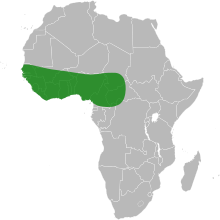
Back أرز إفريقي Arabic ارز افريقى ARZ अफिरकी धान Bihari Arròs africà Catalan Oryza glaberrima CEB Oryza glaberrima Spanish Oryza glaberrima Basque Maaroori FF Afrikanriisi Finnish Oryza glaberrima French
| Oryza glaberrima | |
|---|---|

| |
| Scientific classification | |
| Kingdom: | Plantae |
| Clade: | Tracheophytes |
| Clade: | Angiosperms |
| Clade: | Monocots |
| Clade: | Commelinids |
| Order: | Poales |
| Family: | Poaceae |
| Genus: | Oryza |
| Species: | O. glaberrima
|
| Binomial name | |
| Oryza glaberrima | |

| |
| Wild range. Cultivated range is much larger. | |
Oryza glaberrima, commonly known as African rice, is one of the two domesticated rice species.[1] It was first domesticated and grown in West Africa around 3,000 years ago.[2][3] In agriculture, it has largely been replaced by higher-yielding Asian rice (O. sativa),[2] and the number of varieties grown is declining.[1] It still persists, making up an estimated 20%[4] of rice grown in West Africa. It is now rarely sold in West African markets, having been replaced by Asian strains.[5]
In comparison to Asian rice, African rice is hardy, pest-resistant, low-labour, and suited to a larger variety of African conditions.[1] It is described as filling, with a distinct nutty flavour.[4] It is also grown for cultural reasons; for instance, it is sacred to followers of Awasena (a traditional African religion) among the Jola people,[6] and is a heritage variety in the United States.[7]
Crossbreeding between African and Asian rice is difficult, but there exist some crosses.[8][9][10] Jones et al. 1997 and Gridley et al. 2002 provide hybrids combining glaberrima's disease resistance and sativa's yield potential.[11]
- ^ a b c Linares, Olga F. (2002-12-10). "African rice (Oryza glaberrima): History and future potential". Proceedings of the National Academy of Sciences. 99 (25): 16360–16365. Bibcode:2002PNAS...9916360L. doi:10.1073/pnas.252604599. ISSN 1091-6490. PMC 138616. PMID 12461173.
- ^ a b Cite error: The named reference
genomewas invoked but never defined (see the help page). - ^ Cite error: The named reference
carneywas invoked but never defined (see the help page). - ^ a b Cite error: The named reference
PROT4Uwas invoked but never defined (see the help page). - ^ Ikhioya, Sunny; Oritse, Godwin (2013-10-07). "Smuggled rice floods Nigerian market, as merchants suffer losses". Vanguard.[permanent dead link]
- ^ Thiam, Pierre; Sit, Jennifer (2015). "Senegal: Modern Senegalese Recipes from the Source to the Bowl". A System of Rice Production, Broken. Lake Isle Press.
- ^ Cite error: The named reference
blackricewas invoked but never defined (see the help page). - ^ Cite error: The named reference
indiawas invoked but never defined (see the help page). - ^ Cite error: The named reference
crosswas invoked but never defined (see the help page). - ^ GRAIN (2009). "Nerica: another trap for small farmers in Africa" (PDF).
- ^ Sweeney, Megan; McCouch, Susan (2007). "The Complex History of the Domestication of Rice". Annals of Botany. 100 (5). Oxford University Press: 951–957. doi:10.1093/aob/mcm128. PMC 2759204. PMID 17617555. S2CID 14266565.